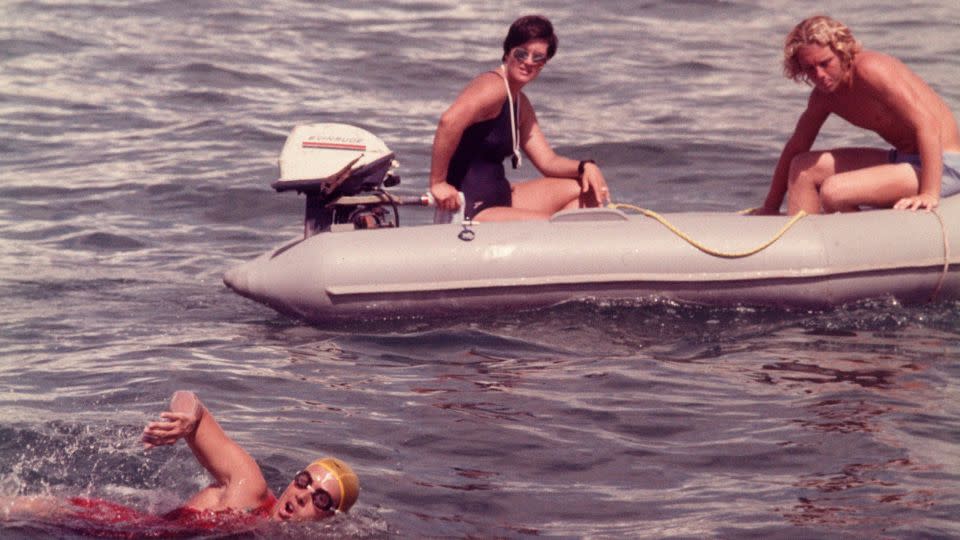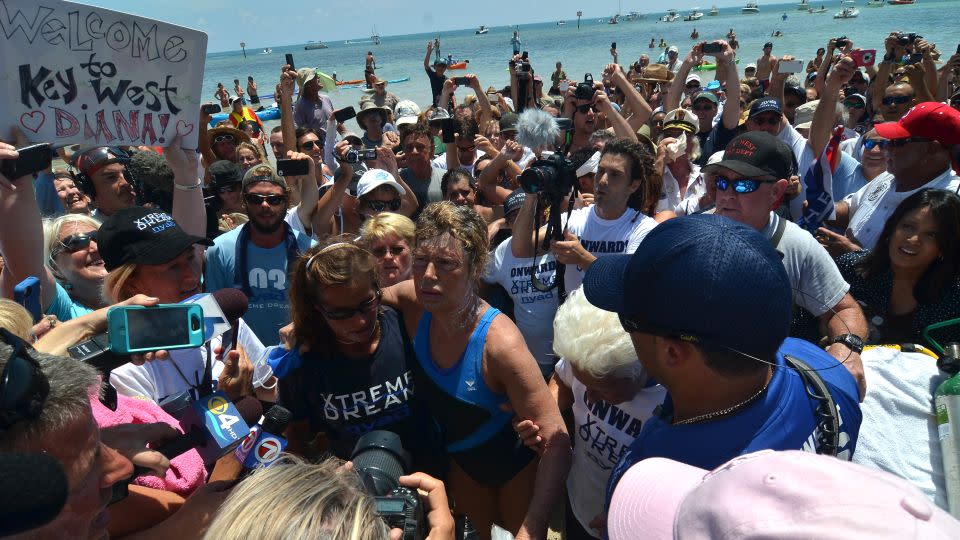Opinion: ‘Nyad’ tells an incredible story, but for any Cuban American it brings pain
- Oops!Something went wrong.Please try again later.
- Oops!Something went wrong.Please try again later.
Editor’s Note: Elena Sheppard is a culture writer who focuses on books, fashion, theater and history. Her first book, “The Eternal Forest: A Memoir of the Cuban Diaspora” is forthcoming from St. Martin’s Press. The views expressed here are her own. View more opinion on CNN.
Diana Nyad was obsessed with completing what is called the “Mount Everest” of swims — the 110-mile swim from Cuba to Key West. In 1978, when she was 28 years old, she attempted the swim for the first time. She swam for 41 hours and 47 minutes straight before currents and dangerous swells forced her to stop. In 2013, at 64 years old and after five attempts over 35 years, Nyad was successful. The swim took her 53 hours. “I never knew I would suffer the way I did,” she told CNN Chief Medical Correspondent Dr. Sanjay Gupta in an interview.

In the new film “Nyad,” starring Annette Bening as the titular swimmer, the narrative focuses on the chapter in Nyad’s life, decades after her first attempt, when she became obsessively driven to complete the Cuba to Key West swim — or die trying. It’s an undeniable story of willpower, perseverance and human achievement. But for any Cuban or Cuban American like me, the Cuba to Key West stretch of ocean, called the Florida Straits, will never be unemotional or apolitical.
Nyad spent about $1 million to make her dream come true — with the cost of training and support teams and the necessary equipment. Meanwhile, that same route is the one taken by countless Cubans who have fled their island on homemade rafts called balsas. They have left clutching babies, without supplies, on barely floating vessels. Thousands have died in the Florida Straits trying to reach the US.
“Cuba, that magical place across the water, forbidden land,” Nyad’s character says in the film. Or as Nyad’s stepfather in the film says of the island, “So close you could almost swim there.”
That mirage of proximity is a powerful one, for Nyad and for desperate Cubans alike. Since Cuba’s Revolution in 1959, the neighbors just across the water from one another have been anything but cordial. Since 1962, the trade embargo on Cuba by the US has caused the island and its people to suffer immeasurably. The Florida Straits have filled with migrants on many occasions — often during moments when revolutionary leader Fidel Castro told his people they could leave the island without being stopped. For the impoverished population, homemade rafts are often the only way. In the mid-1990s after the fall of Cuba’s main trading partner, the Soviet Union, this declaration was made again, and the balsero crisis began.

Between August 13 and September 13, 1994, the US Coast Guard detained 30,879 balseros attempting to cross the Florida Straits. They left by sea, in homemade rafts made of whatever they could find — Styrofoam pieces, wooden boards strapped together, car tops on anything that could float. According to a 1995 study, as many as 100,000 Cubans may have died between 1959 and 1994 while attempting to cross the Straits. While those dramatic numbers have ebbed and flowed in the decades since, it is those people I think of when I watch Nyad’s story.
The film, which is based on Nyad’s memoir, “Find a Way,” and directed by Jimmy Chin and Elizabeth Chai Vasarhelyi, the husband-and-wife team behind “Free Solo,” focuses intently on the team Nyad required to accomplish her truly death-defying achievement. There is Nyad’s coach Bonnie (played by Jodie Foster), her navigator, her jellyfish specialist, the men in charge of creating a shark shield, the list goes on. The real life Nyad made the trip thanks to a crew of dozens of others.
That she was able to eventually complete her swim, becoming the first person ever to swim to Key West from Cuba without the assistance of a shark cage, is a testament not only to her incredible will and strength of both body and mind, but also to the vast amount of resources that were poured into funding her personal dream. As she said when she reached the shores of Key West, “It looks like a solitary sport, but it’s a team.”

Cuba itself is hardly touched in the movie, but in the moments that it is it’s done through the haze of romanticism. In one rapid-fire montage underscored by the lines, “Cuba is a magical place full of music, full of life,” the audience is hit with images of 1950s fluorescent night club signs, and big bands, and Castro’s smiling face. There are a few quick flashes that hint to the Cuban Missile Crisis, but mostly Cuba is treated as any other stretch of sand. And perhaps for the purposes of Nyad and her swim it is.
In 1994, at the height of the balsero crisis, President Bill Clinton instituted a policy called “wet foot, dry foot” wherein if a Cuban migrant escaping over the Florida Straits was to get one foot on dry American soil before they were caught by US officials, they’d be permitted to stay. If they got caught at sea, they’d be returned to Cuba. There is footage of those scenes of desperate people dodging the Coast Guard, trying however they could to get their feet on land. Intentionally or not, there is a scene in “Nyad” that is something of a funhouse perversion of that heartbreaking dance. As she completes her swim, Nyad is cheered onto the beach by her coach Bonnie. Nyad must get two ankles out of the water on her own, without assistance from anyone else, for the swim to qualify for the record books. “Two ankles out of the water, you can do it,” Bonnie says, beckoning Nyad to the beach. Dry feet.
Of course, “Nyad” isn’t a movie or a story about Cuba and it’s not intended to be. It’s a story about one American’s triumph. But the Florida Straits are a terrifying stretch of water for anyone with Cuban blood — an aquatic expanse at once filled with promise and misery and terror.
“We thought we were going to die the whole time. We had no motor, we had no water, we had no food, so for me to go back and talk about it is very difficult,” Cuban native wrestling head coach Fidel Albelo told Forbes in 2016 about his experience as a balsero. “It’s an indescribable torture.”
Nyad’s trip, at least as portrayed in the film, was difficult too — but sport and escape are two very different journeys even if they trod the same path.
The Florida Straits are still a thoroughfare for migrants. In 2022, thousands of Cuban refugees were picked up by the US Coast Guard, the most since the 1990s crisis. Heartbreakingly, there were, of course, vessels found empty — only the remnants of who occupied the balsas before they drowned.
“Nyad” tells an incredible story about one woman’s remarkable achievement, but for any Cuban American watching, I imagine it will be painfully hard to separate Nyad’s personal record from the multitudes of Cubans who never got two feet on dry land.
For more CNN news and newsletters create an account at CNN.com

